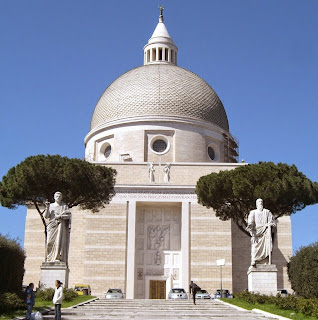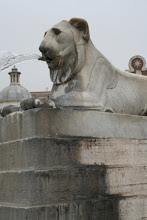My temporary home in Rome is in the Rione (suburb or region) of Monti, one of the most ancient quarters in
Rome, with a succession of building styles that cover over 2,500 years of history - roman, medieval, renaissance, baroque and modern. The name derives from the fact that it comprised
four of Rome's seven hills, and I can attest very much to the topography, as I am constantly climbing up or walking down steep streets that remain pretty well as they were laid out in the middle ages. One of these streets, bordered by medieval buildings, a large and gloomy church and an adjoining convent, is the Via In Selci. Late on a Spring afternoon, the sun turns its buildings to burnt umbers and rose golds.
.jpg) |
| Via In Selci |
A little way down the Via In Selci is Vino Roma. Vino Roma has been on my "must visit" list for about three years now, ever since I read about Hande Leimer, its founder, on one of Rome's best food blogs, Katie Parla's "Parla Food".
Hande has done it tough as a female sommelier, especially in the machismo-dominated wine world that is Rome. But she has turned her venture into a real success - the week I looked at potential wine tastings I noticed there were events scheduled every day except Monday. So, liking the sound of Hande's Wine & Cheese Dinner, I reserved my place and made my way down the Via In Selci last Thursday night. At 6pm the sun was still high in the sky (at the moment, it gets dark a little after 8 at night).
Vino Roma occupies a wine studio space with a very long tasting table, and it soon filled up with eight wine lovers from Wales, Israel, America and Australia. Hande explained we would taste five wines, two of them on an empty stomach, to give us the opportunity to compare our wines with, and without food.
Whilst in Rome I've tried to stick to local wines from the Lazio region (of which Rome is part) but I have to say, the Frascatis, Trebbianos and the Est! Est! Est! have been drinkable, but not amazing. So it was interesting to try a wonderful dry white wine from Lombardy in the far north of Italy, and a stunning and gutsy red, the Nero d'Avola, from Sicily in the far south.
.jpg) |
| Hande explains the concept of 'Orange' wine |
After learning to look, smell and taste our wine we progressed from a sparkling prosecco and a flinty fiano to an "orange" wine, a new/old method of winemaking that involves using white grapes with a red wine technique, which puts some tannins into the wine. And it really does have an orange hue! Food began to accompany our wine including suppli, risotto balls particular to the Lazio region and made with cacio cheese and pepper, fresh ricotta (once it's refrigerated it's ruined, according to Hande. Ours was hours old.), salame, prosciutto, mozzarella, rocket, those wonderful Italian tomatoes, fava beans, pecorino, country bread, artisan cheeses. With a sweet Garganega wine from the Veneto we tried a delicacy from Sardinia - cave-aged cheese helped along via a second fermentation by worms. Worms? Yes, really. It was incredibly strong but paired well with the desert wine.
.jpg)
I learned a lot and had a great evening - not only from enjoying the company and the wine but also from trying some new and delicious food. In relation to the wine, there were a couple of things Hande told us that stayed in my memory:
Look at the colour of red wine, make a 'lake' in your glass by tipping it to one side. Is the "shore" rusty or pink? If it's rusty it's aged, but aged not necessary in years, rather it has more oxidation (although it could be both).
No Italian vineyards by law can be irrigated once they're established. The roots of our vines in Australia, and in the US, go down about three feet. In Italy, the vines have roots to 17 feet.
We wound up about 9.30 with some people actually having to get on planes the next day. I had an easy walk home accompanied by the rosy glow only good company, food and wine can bring. And slept brilliantly!
.jpg)
.jpg)

.jpg)

.jpg)
.jpg)
.jpg)
%2B(360x640).jpg)
.jpg)


.jpg)
.jpg)



.jpg)
.jpg)
.jpg)

.jpg)
.jpg)

.jpg)
.jpg)
.jpg)
.jpg)
.jpg)
.jpg)
.jpg)
.jpg)
.jpg)
.jpg)
.jpg)
.jpg)
.jpg)
.jpg)

.jpg)
.jpg)
%2B(683x1024).jpg)
.jpg)
.jpg)
